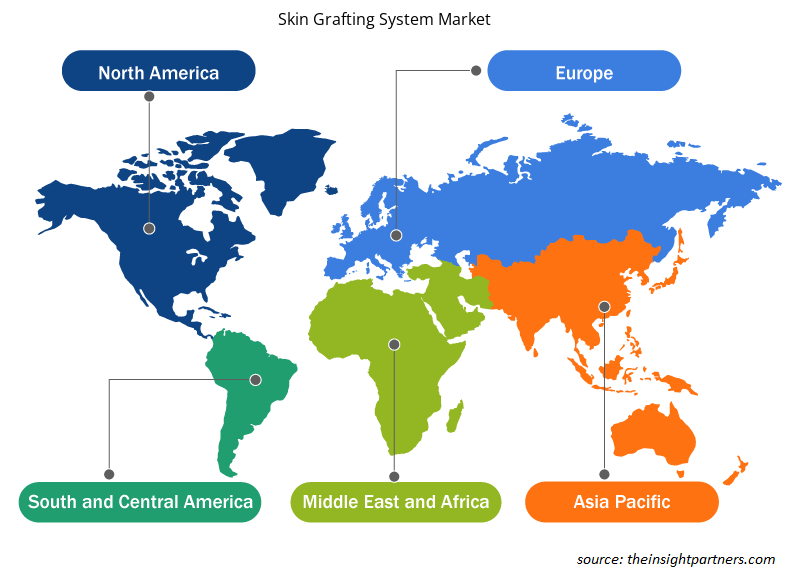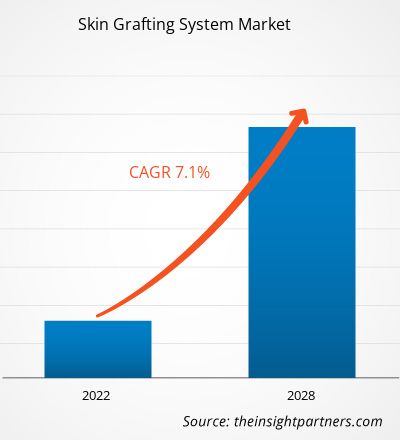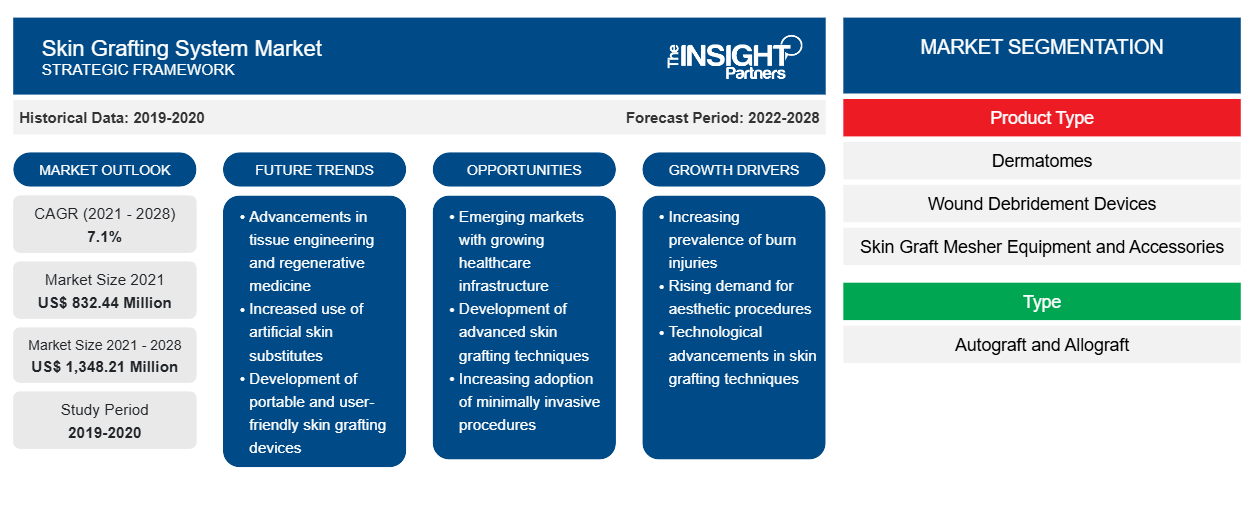Der Markt für Hauttransplantationssysteme soll von 832,44 Millionen US-Dollar im Jahr 2021 auf 1.348,21 Millionen US-Dollar im Jahr 2028 anwachsen; für den Zeitraum 2021–2028 wird mit einer durchschnittlichen jährlichen Wachstumsrate von 7,1 % gerechnet.CAGR of 7.1% during 2021-2028.
Hauttransplantationssysteme sind eine Reihe von Geräten, Ausrüstungen, Instrumenten und Verbrauchsmaterialien, die im Hauttransplantationsprozess verwendet werden, wie z. B. Probenentnahme, Netzbildung und endgültige Transplantation. Einige Schritte im Hauttransplantationsprozess bestehen aus der Hauttransplantatentnahme (mit Dermatom), der Hautvernetzung (mit Hautvernetzungsausrüstung und Zubehör), dem Wunddebridement (mit Wunddebridementgeräten) und allen damit verbundenen Verbrauchsmaterialien und Instrumenten im Prozess der Hauttransplantation. Hauttransplantationen werden bei verschiedenen Arten von Wunden durchgeführt, wie z. B. Verbrennungen, chronischen Wunden, traumatischen Wunden und chirurgischen Wunden. Hauttransplantationen fördern den Heilungsprozess in Fällen, in denen der Heilungsprozess extrem langsam oder vernachlässigbar sein kann.dermatome), skin meshing (using skin mesher equipment and accessories), wound debridement (using wound debridement devices), and all the related consumables and instruments in the process of skin grafting. Skin grafting is done on various types of wounds, such as burns, chronic wounds, traumatic wounds, and surgical wounds. Skin grafts promote the healing process in cases where the healing process may be extremely slow or negligible.
Der Markt für Hauttransplantationssysteme ist nach Produkttyp, Typ, Wundtyp, Endverbraucher und Geografie segmentiert. Der Markt ist geografisch grob in Nordamerika, Europa, Asien-Pazifik, den Nahen Osten und Afrika sowie Süd- und Mittelamerika unterteilt. Der Marktbericht für Hauttransplantationssysteme bietet Einblicke und eine eingehende Analyse des Marktes und betont Parameter wie Marktgröße, Trends und Dynamik, technologische Fortschritte auf dem Markt sowie die Analyse der Wettbewerbslandschaft der führenden Marktteilnehmer auf dem Markt für Hauttransplantationssysteme.
Passen Sie diesen Bericht Ihren Anforderungen an
Sie erhalten kostenlose Anpassungen an jedem Bericht, einschließlich Teilen dieses Berichts oder einer Analyse auf Länderebene, eines Excel-Datenpakets sowie tolle Angebote und Rabatte für Start-ups und Universitäten.
-
Holen Sie sich die wichtigsten Markttrends aus diesem Bericht.Dieses KOSTENLOSE Beispiel umfasst eine Datenanalyse von Markttrends bis hin zu Schätzungen und Prognosen.
Einige Faktoren wie die zunehmende Zahl von Verbrennungen, die steigende Prävalenz von Hautkrebs und Diabetes sowie die wachsende Vielfalt an Hauttransplantatquellen für Transplantationssysteme werden voraussichtlich in den kommenden Jahren erhebliche kurz-, mittel- und langfristige Auswirkungen auf den Markt für Hauttransplantationssysteme haben. Die Kosten für Hauttransplantationen hemmen jedoch das Marktwachstum. Der Marktbericht identifiziert Chancen und zukünftige Markttrends, die mögliche Auswirkungen auf das Marktwachstum haben können.
Markteinblicke
Zunehmende Fälle von Verbrennungen
Hauttransplantate werden vor allem bei Verbrennungen und Hautinfektionen eingesetzt. Die Zahl der Todesfälle durch Verbrennungen ist gestiegen. Nach Angaben der American Burn Association gab es 2016 in den USA 3.390 Todesfälle durch Brände unter der Zivilbevölkerung, darunter 2.800 Todesfälle durch Brände in Wohngebäuden, 150 Todesfälle durch Brände in Nicht-Wohngebäuden, 355 Todesfälle durch Fahrzeugbrände und 85 Todesfälle durch Brände im Freien und nicht klassifizierte Brände außer Gebäude- oder Fahrzeugbränden. Die Statistiken umfassten über 14.650 Verletzungen. Statistiken haben gezeigt, dass es zwischen 2011 und 2018 bei Feuerwehrleuten in den USA im Einsatz 58.520 Verletzungen gab. Die National Fire Protection Association (NFPA) schätzt, dass es im Jahr 2020 1.388.500 Brände gab, die 3.500 Todesfälle und 15.200 Verletzungen unter der Zivilbevölkerung verursachten. Die NFPA stellte fest, dass die Zahl der Todesfälle durch Brände seit 1980 zwar um 46 % zurückgegangen ist, jedoch seit dem Rekordtief von 2.855 Todesfällen im Jahr 2012 um 23 % gestiegen ist. Die Ergebnisse der NFPA kamen auch zu dem Schluss, dass Brände in Ein- und Zweifamilienhäusern 63,7 % der zivilen Opfer und 56,6 % der Verletzungen ausmachten, gefolgt von Wohnungsbränden, die im Jahr 2020 19,1 % der Verletzungen ausmachten.NFPA) estimated that 1,388,500 fires took place in 2020, which caused 3,500 civilian deaths and 15,200 injuries. The NFPA found that while the number of fire-related deaths declined by 46% since 1980, there was an increase of 23% from the record low number of deaths in 2012, which stood at 2,855 to the present figure. The NFPA findings also concluded that one-and two-family home fire accounted for 63.7% of civilian casualties and 56.6% of injuries, followed by apartment fires which stood at 19.1% of injuries in 2020.
Ebenso starben laut den 2018 veröffentlichten Statistiken der Weltgesundheitsorganisation (WHO) weltweit mehr als 180.000 Menschen an Verbrennungen. Die meisten Verbrennungen werden in Ländern mit niedrigem oder mittlerem Einkommen in Afrika und Südostasien gemeldet. Die WHO schätzt beispielsweise, dass in Indien jedes Jahr eine Million Menschen mittelschwere oder schwere Verbrennungen erleiden. In Bangladesch, Kolumbien, Ägypten und Pakistan führen 17 % der Verbrennungen bei Kindern zu vorübergehenden Behinderungen, während 18 % eine dauerhafte Behinderung hinterlassen. Mit der steigenden Zahl der Verbrennungen ist in den letzten Jahren auch die Nachfrage nach Hauttransplantaten zum Ersatz der beschädigten Hautpartien gestiegen. Laut den Statistiken des National Burn Repository (NBR) wurden im Jahr 2016 rund 486.000 Verbrennungen medizinisch behandelt. Über 60 % der Krankenhausaufenthalte im Zusammenhang mit Verbrennungen erfolgten in 128 Verbrennungszentren. Zudem sind die Behandlungskosten weltweit gestiegen. So behandelte der britische National Health Service (NHS) im Jahr 2017 etwa 15.000 Patienten mit Brandverletzungen. Die Behandlungskosten beliefen sich auf über 24,94 Millionen US-Dollar (20 Millionen GBP). In den USA werden jährlich über 7,9 Milliarden US-Dollar für Notaufnahmebesuche und die Behandlung von Brandverletzungen in Krankenhäusern ausgegeben.NBR) statistics, in 2016, around 486,000 burn injuries received medical treatment. Over 60% of the hospitalizations related to burn injuries were admitted to 128 burn centers. Also, the cost of treatment increased worldwide. For instance, in 2017, the National Health Services (NHS), UK, treated ~15,000 patients with burn injuries, and the cost of treatment was over US$ 24.94 million (i.e., GBP 20 million). Similarly, in the US, every year, more than US$ 7.9 billion is spent on emergency room visits, and hospital burn cares.
Darüber hinaus zwingt die steigende Zahl von Brandverletzungen die Gesundheitssysteme dazu, Brandbehandlungsprogramme und -managementdienste einzuführen. Darüber hinaus hat Saudi-Arabien ein Brandbehandlungsprogramm eingeführt, im Rahmen dessen 17 Brandbehandlungseinrichtungen im ganzen Land verteilt sind. Die Organisationen im Land setzen die Brandbehandlung aktiv durch, um Hauttransplantationen zu verbessern. Die Brandbehandlungsdienste der Abteilung für Verbrennungen und plastische Chirurgie der Prince Sultan Military Medical City (PSMMC) umfassen beispielsweise ein Hauttransplantationsprogramm und eine langfristige Rehabilitation. Somit trägt die steigende Zahl von Verletzungen erheblich zur wachsenden Nachfrage nach Hauttransplantationsbehandlungen bei und steigert so das Marktwachstum.PSMMC) burn care services include a skin grafting program and long-term rehabilitation. Thus, the increasing number of injuries is contributing significantly to the growing demand for skin graft treatments, thereby increasing the market growth.
Produkttypbasierte Einblicke
Der globale Markt für Hauttransplantationssysteme ist nach Produkttyp in Dermatome, Wunddebridementgeräte , Hauttransplantat-Mesher-Ausrüstung und Zubehör und Sonstiges unterteilt. Das Segment Wunddebridementgeräte wird in den kommenden Jahren voraussichtlich den größten Marktanteil halten. Allerdings wird das Segment Dermatome im Prognosezeitraum voraussichtlich die höchste durchschnittliche jährliche Wachstumsrate verzeichnen. Der Markt für das Segment Dermatome ist weiter unterteilt in elektrische Dermatome, Trommeldermatome und Sonstiges. Außerdem ist der Markt für das Segment Haut-Mesher-Ausrüstung und Zubehör in Mesher-Schneider, Mesher-Träger und sonstige Begleitprodukte unterteilt.dermatomes, mesher equipment and accessories, and others. The wound debridement devices segment is expected to hold the largest share of the market in the coming years. However, the dermatomes segment is expected to register the highest CAGR during the forecast period. The market for the dermatomes segment is further segmented into electric dermatomes, drum dermatomes, and others. Also, the market for the skin mesher equipment and accessories segment is subsegmented into mesher cutters, mesher carriers, and other companion products.
Typbasierte Erkenntnisse
Basierend auf dem Typ ist der Markt für Hauttransplantationssysteme in Autograft und Allograft unterteilt. Das Autograft-Segment hatte 2021 einen größeren Marktanteil und wird voraussichtlich im Prognosezeitraum einen erheblichen Marktanteil halten. Es wird jedoch erwartet, dass das Allograft-Segment von 2021 bis 2028 eine höhere durchschnittliche jährliche Wachstumsrate verzeichnet.autograft and allograft. The autograft segment held a larger share of the market in 2021 and is expected to hold a significant share of the market during the forecast period. However, the allograft segment is expected to register a higher CAGR from 2021 to 2028.
Erkenntnisse basierend auf Wundtypen
Basierend auf dem Wundtyp ist der Markt für Hauttransplantationssysteme in Verbrennungen, chronische Wunden, traumatische Wunden, chirurgische Wunden und andere unterteilt. Das Segment Verbrennungen wird im Prognosezeitraum voraussichtlich den größten Marktanteil halten. Das Segment chirurgische Wunden wird jedoch voraussichtlich zwischen 2021 und 2028 die höchste durchschnittliche jährliche Wachstumsrate verzeichnen.
Endbenutzerbasierte Erkenntnisse
Basierend auf dem Endverbraucher ist der Markt für Hauttransplantationssysteme in Krankenhäuser, ambulante chirurgische Zentren und Fachkliniken unterteilt. Das Krankenhaussegment hielt den größten Marktanteil und wird im Prognosezeitraum voraussichtlich die höchste durchschnittliche jährliche Wachstumsrate verzeichnen.
Verschiedene auf dem Markt für Hauttransplantationssysteme tätige Unternehmen verfolgen Strategien wie Produkteinführungen, Fusionen und Übernahmen, Kooperationen, Produktinnovationen und die Erweiterung ihres Produktportfolios, um ihre Präsenz weltweit auszubauen, einen Markennamen zu wahren und die wachsenden Anforderungen der Verbraucher zu erfüllen.
Regionale Einblicke in den Markt für Hauttransplantationssysteme
Die regionalen Trends und Faktoren, die den Markt für Hauttransplantationssysteme während des Prognosezeitraums beeinflussen, wurden von den Analysten von Insight Partners ausführlich erläutert. In diesem Abschnitt werden auch die Marktsegmente und die Geografie von Hauttransplantationssystemen in Nordamerika, Europa, im asiatisch-pazifischen Raum, im Nahen Osten und Afrika sowie in Süd- und Mittelamerika erörtert.

- Erhalten Sie regionale Daten zum Markt für Hauttransplantationssysteme
Umfang des Marktberichts über Hauttransplantationssysteme
| Berichtsattribut | Details |
|---|---|
| Marktgröße im Jahr 2021 | 832,44 Millionen US-Dollar |
| Marktgröße bis 2028 | 1.348,21 Millionen US-Dollar |
| Globale CAGR (2021 - 2028) | 7,1 % |
| Historische Daten | 2019-2020 |
| Prognosezeitraum | 2022–2028 |
| Abgedeckte Segmente |
Nach Produkttyp
|
| Abgedeckte Regionen und Länder |
Nordamerika
|
| Marktführer und wichtige Unternehmensprofile |
|
Dichte der Marktteilnehmer für Hauttransplantationssysteme: Die Auswirkungen auf die Geschäftsdynamik verstehen
Der Markt für Hauttransplantationssysteme wächst rasant, angetrieben durch die steigende Nachfrage der Endnutzer aufgrund von Faktoren wie sich entwickelnden Verbraucherpräferenzen, technologischen Fortschritten und einem größeren Bewusstsein für die Vorteile des Produkts. Mit steigender Nachfrage erweitern Unternehmen ihr Angebot, entwickeln Innovationen, um die Bedürfnisse der Verbraucher zu erfüllen, und nutzen neue Trends, was das Marktwachstum weiter ankurbelt.
Die Marktteilnehmerdichte bezieht sich auf die Verteilung der Firmen oder Unternehmen, die in einem bestimmten Markt oder einer bestimmten Branche tätig sind. Sie gibt an, wie viele Wettbewerber (Marktteilnehmer) in einem bestimmten Marktraum im Verhältnis zu seiner Größe oder seinem gesamten Marktwert präsent sind.
Die wichtigsten auf dem Markt für Hauttransplantationssysteme tätigen Unternehmen sind:
- Zimmer Biomet
- B. Braun Medical
- Exsurco Medical, Inc.
- Aygun Surgical Instruments Co., Inc.
- De Soutter Medical
Haftungsausschluss : Die oben aufgeführten Unternehmen sind nicht in einer bestimmten Reihenfolge aufgeführt.

- Überblick über die wichtigsten Akteure auf dem Markt für Hauttransplantationssysteme
Firmenprofile
- Zimmer Biomet
- B. Braun Medical
- Exsurco Medical, Inc.
- Aygun Surgical Instruments Co., Inc.
- De Soutter Medical
- Lutz GmbH & Co. KG
- Smith & Neffe
- Stryker Corp.
- Integra Lifesciences Holdings Corp.
- Humeca BV
- Historische Analyse (2 Jahre), Basisjahr, Prognose (7 Jahre) mit CAGR
- PEST- und SWOT-Analyse
- Marktgröße Wert/Volumen – Global, Regional, Land
- Branchen- und Wettbewerbslandschaft
- Excel-Datensatz
Aktuelle Berichte
Erfahrungsberichte
Grund zum Kauf
- Fundierte Entscheidungsfindung
- Marktdynamik verstehen
- Wettbewerbsanalyse
- Kundeneinblicke
- Marktprognosen
- Risikominimierung
- Strategische Planung
- Investitionsbegründung
- Identifizierung neuer Märkte
- Verbesserung von Marketingstrategien
- Steigerung der Betriebseffizienz
- Anpassung an regulatorische Trends























 Kostenlose Probe anfordern für - Markt für Hauttransplantationssysteme
Kostenlose Probe anfordern für - Markt für Hauttransplantationssysteme